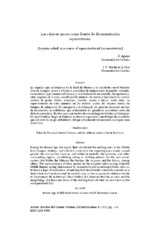Los relieves asirios como fuente de documentación equinotécnica
Assyrian reliefs as a source of equinotechnical documentation
Autor
Agüera, Eduardo
Martín de la Cruz, José C.
Editor
UCOPressFecha
2021Materia
Edad del BronceOriente Próximo
Caballo
relieves asirios
fuente histórica
Bronze Age
Middle East
horse
Assirian reliefs
historical source
METS:
Mostrar el registro METSPREMIS:
Mostrar el registro PREMISMetadatos
Mostrar el registro completo del ítemResumen
Los équidos que sustituyeron en la Edad del Bronce a los existentes en el Próximo Oriente (onagros, asnos e híbridos), procedían de emigraciones de pueblos nómadas euroasiáticos que cruzaron el Cáucaso y se establecieron en Anatolia, Mesopotamia y otras regiones de la zona, constituyendo animales de monta o tracción de los nuevos centros de poder: hititas, mitannios, hurritas, asirios e hicsos, entre otros. La representación de estos animales en los relieves asirios del imperio medio, en tiempos de Salmanasar III, Senaquerib y Asurbanipal, nos permite reconocer un tipo de locomoción, la ambladura, que actualmente los ganaderos consideran como un defecto a erradicar. En otro caso, con motivo de una entrega de tributos a Salmanasar III, en el Obelisco Negro de Nimrud, se observa la posición y morfología de un caballo que presenta los rasgos definitorios del que actualmente reconocemos en el pura raza árabe (AA). During the Bronze Age, the equids that substituted the existing ones in the Middle East (onagers, donkeys, and hybrids), came from the migrating euro Asiatic nomad people who crossed the Caucasus and settled in Anatolia, Mesopotamia, and other surrounding regions, constituting riding or drafting animals for the new power centers: the Hittite, the Mitanni, the Hurrian, the Assyrian, and the Hyksos, among others. The representation of these animals in the Assyrian relief carvings from the Middle Empire, during Shalmaneser III, Sennacherib and Assurbanipal times, allow us to know a type of locomotion, of ambling that stockbreeders currently consider as a defect that must be eliminated. In another case, on the occasion of a delivery tribute to Shalmaneser III, in Nimrud’s Black Obelisk, it is observed that the position and the morphology of a horse are those of the defining traits of what we now know as the Arab purebred (AA).

